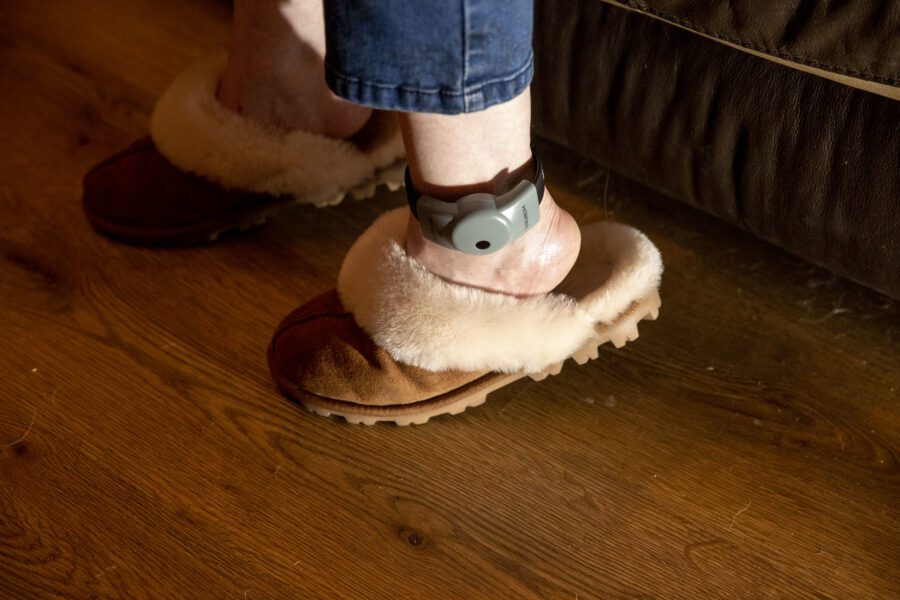Introduction to: Electronic Monitoring
What is electronic monitoring?
Electronic monitoring (EM) (also known as tagging) is a system that uses technology to monitor curfews and conditions of an order or licence from a court or the prison service.
Who is electronic monitoring for?
Where it is safe, people may be given a community sentence that restricts their liberty through electronic tagging and curfews. It could for example be used as a restricted movement requirement as part of a community payback order (CPO) or a Drug Treatment & Testing Order (DTTO). EM can also be used as a condition of bail and also for certain licences through the Scottish Prison Service. EM allows individuals to remain in the community, which means they stay connected to their family, responsibilities and support for their recovery.

How does electronic monitoring work?
EM uses a radio frequency signal to monitor someone’s location to check if they are complying with an order or licence.
The person wears a tag around their ankle which is about the size of a digital watch. The tag communicates with a monitoring unit which is installed in their home or an address where they should not approach or enter. The home monitoring unit continuously collects and stores data from signals sent by the tag. If it doesn’t detect a signal during a curfew period – or it picks up a signal showing the person is in a location they are ordered to stay away from – an alert will be transmitted to the monitoring control centre.
Outside of the curfew hours the person can go about their business such as to work, or to attend appointments which aid their recovery or help their reintegration. And it can also be used to disrupt patterns of behaviour such as to ensure someone stays at home during the evenings.
What are the benefits of electronic monitoring?
Prison can damage employment and positive social networks in the community, whereas remaining in the community allows these connections to be maintained and developed.
Electronic monitoring, in combination with support from justice and other services, can help to reduce further offending by addressing a person’s needs and the causes of offending within a safe, managed community environment. This can also support people to comply with the justice system, to attend court appointments and reduce the likelihood of breaching bail or a community-based order.

How is it determined if someone is suitable for electronic monitoring?
EM is a tool to support people to comply with an order or licence. Justice social work make an assessment around risk and suitability. They also need to consider what support options are available to address a person’s needs and the causes of their offending behaviour as well as whether they would be suitable for a tag. Support may also be needed for their wider family network.
A decision is then made by Sheriffs, judges, and the Scottish Prison Service (such as for early release under Home Detention Curfews).
Can electronic monitoring be used with bail?
EM can be used with standard bail and bail with further restrictions (bail supervision).
Bail with the option of EM is now available across Scotland through the imposition of an Electronic Monitoring Order (EMO) which began being gradually introduced across the country in 2022. This can be considered for anyone where the Crown Office and Procurator Fiscal Service (COPFS) has declared a position of bail opposed and the person is at risk of being remanded in prison at their appearance in court.
When social work services are made aware by the Procurator Fiscal that bail is being opposed, they can complete an assessment of suitability for both bail supervision and EM whilst the individual is held within police or court custody. A Sheriff can ask for this information to assist their decision-making in cases where bail is opposed.
Where the Sheriff is considering imposing bail with further conditions (commonly referred to as bail supervision), they can attach EM as part of that arrangement and request an additional assessment be completed for the individual prior to making a final decision on bail conditions. It is important that this assessment considers the support which would be needed in addition to EM, for example, to explore challenges which could lead to offending behaviour. This may include mental health, housing, employment and substance use services and is the basis of the support and monitoring plan for the person while they remain in the community.
Defence agents can also ensure all information regarding bail supervision and EM is considered by the court through maintaining contact with social work during the period an individual is subject to bail supervision.
How many people have tags?
Scotland currently electronically monitors around 1,800 people every day.
Who monitors tags in Scotland?
G4S are responsible for providing electronic monitoring services through a contract with the Scottish Government.
What is the law around electronic monitoring?
- The Management of Offenders (Scotland) Act 2019 consolidated a number of previous pieces of legislation covering electronic monitoring and came into effect in May 2022.
- The current forms of licence (through the Scottish Prison Service) that can be electronically monitored include:
- Home Detention Curfew (HDC – a form of temporary released managed by the Scottish Prison Service)
- As a condition of Parole
- As a condition of a temporary release licence from prison
